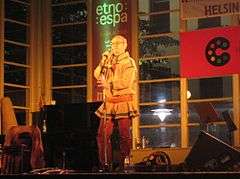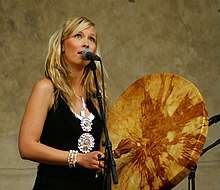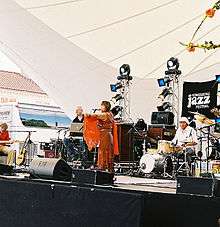Sámi music
In traditional Sámi music songs (e.g. Kvad[1] and Leudd songs[2]) and joiks are important musical expressions of the Sámi people and Sámi languages. The Sámi also use a variety of musical instruments, some unique to the Sámi, some traditional Scandinavian, and some modern introductions.

Highly spiritual songs called joiks (Northern Sámi: luohti; Southern Sámi: vuolle) are the most characteristic song type. (The same word sometimes refers to lavlu or vuelie songs, though this is technically incorrect.) Joiks may have few or no lyrics, do not rhyme, and have no definite structure. They are typically about any subject of importance to the singer, and vary widely in content. In Northern areas each person often has their own joik, sometimes given to them at birth, which is seen as personal to and representative of them, like a name. Purely folk joiks have declined in popularity over the 20th century, due to the influence of pop radio and religious fundamentalism, especially Laestadianism. Joiking first came to prominence within Sweden and Scandinavia as a whole with the 1959 release of Sven-Gosta Jonsson's "I'm a Lapp", which featured the singer singing about joiking towards heathen stones over a modern, skiffle-like beat. The first commercial recordings of joiking were performed by Nils-Aslak Valkeapää in 1968, in Finland. Valkeapää's recordings, however, differed from traditional hoiking by including both instrumentation and ambient sounds, such as barking dogs and the wind. [3]
Nevertheless, joik performers of some fame include Angelit (former Angelin tytöt, Girls of Angeli), Wimme Saari and Nils-Aslak Valkeapää from Finnish Sápmi. Many modern singers are signed to DAT,[4] the premier record label in Sámi music.
The most famous Sámi singer is Mari Boine of Norway, who sings a type of minimalist folk-rock with joik roots. Some non-Sámi artists, including RinneRadio, Xymox, and Jan Garbarek, have used joik and other Sámi styles in their music.
The Finnish folk metal band Sháman (now known as Korpiklaani) introduced what some call "yoik metal" in the late 1990s, drawing attention to Sámi music in the heavy metal scene. Their music incorporated Sámi elements such as yoik singing, Sámi lyrics, and shamanic drum. The vocalist has also yoiked for fellow Finnish folk metal band Finntroll. Also Finnish black metal band Barathrum (On Eerie album's first track) and Swedish black metal band Arckanum have used joik parts in couple of their songs.
In January 2008, the Sámi artist Ann Marie Anderson, singing "Ándagassii" qualified to the finals of Melodi Grand Prix 2008, (the Norwegian national selection for the Eurovision Song Contest 2008), but she did not win. In Mars 2015 the Swedish Sámi artist Jon Henrik Fjallgren came second with his song "Jag ar fri" in the finals in the national selection for the Eurovision Song Contest 2015. In the October 2018 final episode of the Norwegian televised music contest Stjernekamp, 20-year-old Sámi artist Ella Marie Hætta Isaksen was voted the winner; her final performance on the show was a yoik.[5]
Musical instruments
Some sources have commented on a supposed lack of musical instruments among the Sámi, with one 1885 work noting: "They cannot claim to possess a single instrument of their own, not even the most primitive."[6] Despite these beliefs, the Sámi employ a variety of musical instruments, several unique to them. Among these instruments are the fadno, a reedpipe made from Angelica archangelica stalks, and the Sámi drum. Late 18th century researchers also noted two bagpipes in Lapland:[7] the sak-pipe and the wal-pipe.[8]
Other Sámi instruments of wider Scandinavian usage include the lur (a long horn trumpet),[9][10] and the harpu,[11] a zither similar to the Finnish kantele.[12] Willow flutes are often made from the bark of the quicken tree or mountain ash.[13]
Modern bands use a wide variety of instruments, especially the fiddle, concertina, and accordion.
Gallery

 Sámi vocalist and musician from Gällivare, Sofia Jannok, performing at the Centre Culturel Suédois in Paris, France.
Sámi vocalist and musician from Gällivare, Sofia Jannok, performing at the Centre Culturel Suédois in Paris, France.
 Mari Boine performing at the Kongsberg Jazz in 2007
Mari Boine performing at the Kongsberg Jazz in 2007 Lawra Somby, Sámi joiker and member of the group Adjágas, making a guest appearance with Norwegian heavy metal band Turdus Musicus
Lawra Somby, Sámi joiker and member of the group Adjágas, making a guest appearance with Norwegian heavy metal band Turdus Musicus.jpg) Ande Somby, Sámi vocalist and law professor at the University of Tromsø from Sirbma, Finnmark, performing with his band Vajas at the 2007 Riddu Riđđu festival
Ande Somby, Sámi vocalist and law professor at the University of Tromsø from Sirbma, Finnmark, performing with his band Vajas at the 2007 Riddu Riđđu festival.jpg) A Sámi vocalist performing at the 2007 Riddu Riđđu festival
A Sámi vocalist performing at the 2007 Riddu Riđđu festival.jpg) The crowd gathers to watch a rock band perform at the 2007 Riddu Riđđu festival
The crowd gathers to watch a rock band perform at the 2007 Riddu Riđđu festival Charlotte Qamaniq of Silla at Riddu Riđđu 2019
Charlotte Qamaniq of Silla at Riddu Riđđu 2019.jpg) Ella Marie Hætta Isaksen with Isák the DnB-stage at Grefsenkollen
Ella Marie Hætta Isaksen with Isák the DnB-stage at Grefsenkollen
Notes
- The 12th song from Kalevala V, 395 – 402; Friis, J. A. (1871) "Lappisk mythologi, eventyr og folkesagn: eventyr og folkesagn"; Friis, J.A.
- "Leudd/ sang". Miiva.net. Retrieved 2011-01-07.
- Jones-Bauman, Richard (2001). "From 'I'm a Lapp' to 'I'm a Saami': Popular Music and Changing Images of Indigenous Ethnicity in Scandinavia". Journal of Intercultural Studies. 22 (2): 189–210.
- "DAT". DAT. Retrieved 1 January 2013.
- "Ella Marie Hætta Isaksen wins 'Stjernekamp'" (in Norwegian). NRK.no. 27 October 2018.
- Sophus Tromholt (1885). Under the rays of the aurora borealis: in the land of the Lapps and Kvæns [tr. and] ed. by C. Siewers. pp. 181–. Retrieved 29 May 2011.
- David MacRitchie (1884). Ancient and modern Britons: a retrospect. K. Paul, Trench & co. pp. 399–. Retrieved 25 April 2011.
- Michael Conran (1850). The national music of Ireland: containing the history of the Irish bards, the national melodies, the harp, and other musical instruments of Erin. J. Johnson. pp. 115–. Retrieved 23 April 2011.
- "Luren: tolv lappiske og norske viser og sange" Abraham Wilhelm Brun, 1900.
- April Fast; Keltie Thomas (October 2003). Sweden: the culture. Crabtree Publishing Company. pp. 24–. ISBN 978-0-7787-9329-8. Retrieved 29 May 2011.
- Jan Ling (1997). A history of European folk music. University Rochester Press. pp. 7–. ISBN 978-1-878822-77-2. Retrieved 29 May 2011.
- Arthur Spencer (1978). The Lapps. Crane, Russak. p. 128. ISBN 978-0-8448-1263-2. Retrieved 29 May 2011.
- Carl von Linné and Sir James Edward Smith: Lachesis lapponica. A tour in Lapland, Linnaeus (1811), Volume: 2 (p. 51).
References
- Cronshaw, Andrew. "Joiks of the Tundra". 2000. In Broughton, Simon and Ellingham, Mark with McConnachie, James and Duane, Orla (Ed.), World Music, Vol. 1: Africa, Europe and the Middle East, pp 255–260. Rough Guides Ltd, Penguin Books. ISBN 1-85828-636-0
External links
- Official Angelit Webpage
- Joiks and music, from a multinational student project on minority languages in Europe
- More sample joiks from Hollow Ear magazine
- Sámi Culture Library - Yoik and Music collection of links related to Sámi music
- Sámi traditional music: Ande Somby
- SamiSámicontemporary music: Vajas
- Sámi contemporary music: Transjoik
- Sámi contemporary music: Ulla Pirttijärvi
- Sámi contemporary music: Frode Fjellheim